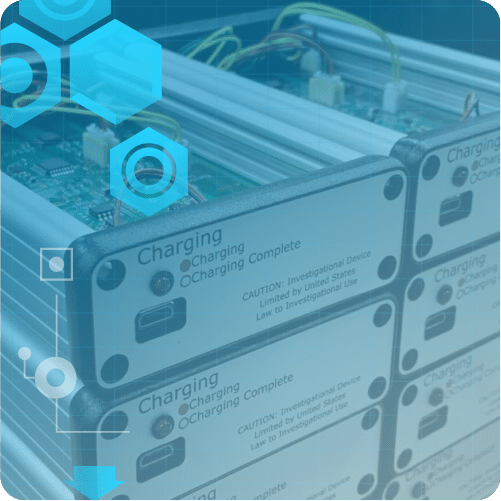FROM: Home-use, manufacturing ready, design controlled, clinical trial replicates
TO: Early bench testbed
In 2017, a research team from the University of Michigan (U-M) led by Dr. Susan Shore—Professor Emerita in Otolaryngology and Molecular and Integrative Physiology—brought in2being a bench model of a novel device that they hoped to develop into a market-ready home-use apparatus for treating tinnitus.
Tinnitus is a condition in which a person hears ringing, roaring, buzzing, or humming in their ears without any external auditory stimulus. According to the National Institutes of Health (NIH), the condition is common, affecting anywhere from 10% to 25% of adults—possibly up to 80 million U.S. residents. In severe or chronic cases, tinnitus prevents patients from carrying out daily activities or makes it difficult to fall asleep.
Although tinnitus is common, there is no cure for the condition. Typical treatments include masking the sounds a patient hears with white noise or using hearing aids to boost ambient sounds. Tinnitus is sometimes treated indirectly by treating anxiety and stress—which can aggravate tinnitus symptoms—with cognitive behavioral therapy (CBT) or drugs.
A significant subset of tinnitus patients (close to 70%) have somatic tinnitus, in which actions like moving the jaw or touching particular areas of the head or neck can modulate the frequency and/or volume of the sounds the patient hears.
The U-M research team discovered that when certain nerves in the dorsal cochlear nucleus area of the brain become hyperactive, they can trigger the perception of sound in the absence of auditory signals. The team postulated that combining auditory input with mild external electrical stimulation could stop the nerve signals that generate tinnitus symptoms in somatic tinnitus patients.
The Starting Point: A Bench Prototype
After confirming the validity of their concept in a guinea pig animal model, Dr. Shore’s team approached in2being for help in developing a medical device for home treatment of tinnitus in humans.
The client had a strong basis in laboratory research, supporting animal studies, and a first bench prototype. But they turned to us for the development of a working model of an at-home tinnitus treatment device, first-in-human clinical trials, regulatory guidance, and consulting on forming a start-up company that would market a proven solution to a nagging problem that affects millions.
The Process: From Design to Human Clinical Trial
As a full-service medical technology consultancy, in2being has expertise across the spectrum of the medical device development process. With some clients, our services run the gamut from proof of concept all the way to market readiness. With others, we jump into the process at whatever stage the client has reached and help for as long as we’re needed.
With the U-M tinnitus team, we provided the following services:
- Mechanical, electrical, and software design: Our team designed a next-generation tinnitus treatment device, producing detailed mechanical and electrical plans and a software operating system.
- Prototyping: In our laboratories, we built the designs into working prototypes that the client used in successful first-in-human clinical trials.
- QSR compliance: As part of the design process, we implemented design controls following the Food and Drug Administration’s (FDA’s) quality system regulation (QSR) and carried out verification and validation testing on the device.
- Regulatory guidance: As we do with every client, we advised the U-M team regarding potential regulatory pathways they could pursue to legally market the new device.
- Additional services: We provided project and vendor management and advised the client on start-up formation and fundraising.
The Results: Successful Clinical Trial and Progress Toward a Marketable Product
After using the device we developed for them in a promising pilot study with 20 tinnitus patients, Dr. Shore’s research team carried out a double-blind, placebo-controlled trial from March 2019 through July 22 with 99 tinnitus patients.
The results—published in JAMA Network Open in June 2023—showed that the treatment device “was effective for adults with somatic tinnitus” and indicated that patients could experience long-lasting relief from tinnitus symptoms through extended treatment (beyond the 24-week study protocol).
Our services helped the project progress from bench prototype to working model and enabled human clinical trials. In the process, we fostered widespread interest in treating tinnitus and helped the client take significant steps toward start-up formation and a marketable product.
To learn more about how in2being can help you through the medical device development process, contact us today.

